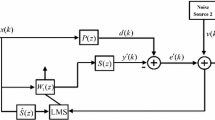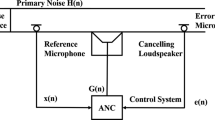Abstract
Linear active noise control (ANC) systems have been used in the past to effectively suppress Gaussian noise. A practical ANC system must consider nonlinearities in the secondary path with a non-minimum phase. For an ANC system to effectively operate in a modern-day acoustic environment with multiple electrical/electronic systems operating in the vicinity, the reference noise source is taken as a non-Gaussian stochastic process. Linear systems have shown unacceptable performance in countering the disturbances that are impulsive in nature. Considering these issues, we propose a family of adaptive algorithms for ANC systems that employ a second-order Volterra filter for accurate modeling of the impulsive disturbances. We utilize the maximum correntropy criterion as the cost function to improve the adaptive filtering process, which generates the most appropriate output signal in the ANC system’s successive iterative stages. The proposed algorithms feature dynamic learning-rate parameters, which improve the tracking performance of the algorithms. Also, a careful selection of the Volterra filter’s kernel size in the proposed algorithms ensures a balance between system stability and convergence rate. These parameters are made automatically adjustable, based on the residual error and the reference input signals, to optimize performance in non-Gaussian environments. A comparison of the proposed algorithms with its counterparts is presented through computer simulations in terms of average noise reduction for different levels of impulsive noise. The proposed algorithms are also compared with each other to find the best performing algorithm in a non-Gaussian environment. Achieved results exhibit the effectiveness of the proposed algorithms in their ability to attenuate impulsive noise in comparison with the existing adaptive algorithms for ANC systems. Later, the proposed algorithm has been implemented for speech enhancement, where the noise from the speech sample is identified and removed using an adaptive filter algorithm. Simulations reveal that the devised algorithm can effectively denoise speech signals. Further, in the last part of the paper, the VF-MCCRMC is modified in accordance with the energy of the error signal, and the simulation results demonstrated the improvement in stability and error performance.






Similar content being viewed by others
Data Availability Statement
Data sharing is not applicable to this article as no datasets were generated or analyzed during the current study.
References
M.T. Akhtar, W. Mitsuhashi, A modified normalized FxLMS algorithm for active control of impulsive noise, in 18th IEEE European Signal Processing Conference (2010). p. 1–5
P.E. An, B. Brown, C.J. Harris, On the convergence rate performance of the normalized least-mean-square adaptation. IEEE Trans. Neural Netw. 8(5), 1211–1214 (1997)
L.S. de Assis, Jurair R de P. Junior, L. Tarrataca, D.B. Haddad, Efficient Volterra systems identification using hierarchical genetic algorithms. Appl. Soft Comput. 85, 105745 (2019)
B. Chen, L. Xing, J. Liang, N. Zheng, J.C. Principe, Steady-state mean-square error analysis for adaptive filtering under the maximum correntropy criterion. IEEE Signal Process. Lett. 21(7), 880–884 (2014)
B. Chen, L. Xing, B. Xu, H. Zhao, N. Zheng, J.C. Principe, Kernel risk-sensitive loss: definition, properties and application to robust adaptive filtering. IEEE Trans. Signal Process. 65(11), 2888–2901 (2017)
W.Y. Chen, R.A. Haddad, A variable step size LMS algorithm, in 33rd Midwest Symposium on Circuits and Systems, vol. 1, (1990). p. 423–426
Z. Dayong, V. DeBrunner, Efficient adaptive nonlinear filters for nonlinear active noise control. IEEE Trans. Circ. Syst. I Regular Paper. 54(3), 669–681 (2007)
N.V. George, G. Panda, A robust filtered-s LMS algorithm for nonlinear active noise control. Appl. Acoust. 73(8), 836–841 (2012)
J.P.F. Guimarães, A.I.R. Fontes, F.B. da Silva, A. de M. Martins, R.V. Borries, Complex correntropy induced metric applied to compressive sensing with complex-valued data, in Southwest Symposium on Image Analysis and Interpretation(SSIAI), IEEE (2018). p. 21–24
D.B. Haddad, M.R. Petraglia, A. Petraglia, A unified approach for sparsity-aware and maximum correntropy adaptive fillters, in 24th IEEE European Signal Processing Conference, (2016). p. 170–174
S.S. Haykin, Adaptive Filter Theory. Prentice-Hall Information and System Sciences Series (Prentice Hall, 1991)
Z. He, H. Ye, E. Li, An efficient algorithm for nonlinear active noise control of impulsive noise. Appl. Acoust. 148, 366–374 (2019)
N.C. Kurian, K. Patel, N.V. George, Robust active noise control: An information theoretic learning approach. Appl. Acoust. 117, 180–184 (2017)
P. Lara, F. Igreja, L.D.T.J. Tarrataca, D.B. Haddad, M.R. Petraglia, Exact expectation evaluation and design of variable step-size adaptive algorithms. IEEE Signal Process. Lett. 26(1), 74–78 (2019)
N. Le Thai, X. Wu, J. Na, Y. Guo, N.T. Tin, P.X. Le, Adaptive variable step-size neural controller for nonlinear feedback active noise control systems. Appl. Acoust. 116, 337–347 (2017)
R. Leahy, Z. Zhou, Y-C. Hsu, Adaptive filtering of stable processes for active attenuation of impulsive noise, in IEEE International Conference on Acoustics, Speech, and Signal Processing, vol. 5, (1995). p. 2983–2986
W. Liu, P.P. Pokharel, J.C. Principe, Correntropy: properties and applications in non-gaussian signal processing. IEEE Trans. Signal Process. 55(11), 5286–5298 (2007)
L. Lu, H. Zhao, Active impulsive noise control using maximum correntropy with adaptive kernel size. Mech. Syst. Signal Process. 87, 180–191 (2017)
T. Padhi, M. Chandra, A. Kar, Performance evaluation of hybrid active noise control system with online secondary path modeling. Appl. Acoust. 133, 215–226 (2018)
T. Padhi, M. Chandra, A. Kar, M.N.S. Swamy, Design and analysis of an improved hybrid active noise control system. Appl. Acoust. 127, 260–269 (2017)
T. Padhi, M. Chandra, A. Kar, M.N.S. Swamy, A new adaptive control strategy for hybrid narrowband active noise control systems in a multi-noise environment. Appl. Acoust. 146, 355–367 (2019)
E. Parzen, On estimation of a probability density function and mode. Ann. Math. Statist. 33(3), 1065–1076 (1962)
R.M.S. Pimenta, L.C. Resende, N.N. Siqueira, D.B. Haddad, M.R. Petraglia, A new proportionate adaptive filtering algorithm with coefficient reuse and robustness against impulsive noise, in 26th IEEE European Signal Processing Conference, (2018). p. 465–469
R.A.D. Prado, F.d. R. Henriques, D.B. Haddad, Sparsity-aware distributed adaptive filtering algorithms for nonlinear system identification, in International Joint Conference on Neural Networks (IJCNN) (2018). p. 1–8
M. Shao, C.L. Nikias, Signal processing with fractional lower order moments: stable processes and their applications. Proc. IEEE 81(7), 986–1010 (1993)
B.W. Silverman, Density Estimation for Statistics and Data Analysis (Routledge, 2018)
J.V.G. de Souza, D.B. Haddad, F.D.R. Henriques, M.R. Petraglia, Novel proportionate adaptive filters with coefficient vector reusing. Circ. Syst. Signal Process. 39(5), 2473–2488 (2019)
L. Tan, J. Jiang, Adaptive second-order Volterra filtered-x RLS algorithms with sequential and partial updates for nonlinear active noise control, in IEEE Conference on Industrial Electronics and Applications (2009). p. 1625–1630
L. Tan, J. Jiang, Adaptive Volterra filters for active control of nonlinear noise processes. IEEE Trans. Signal Process. 49(8), 1667–1676 (2001)
Y. Wang, C. Li, C. Tian, Modified recursive least squares algorithm for sparse system identification, in 7th IEEE International Conference on Modelling, Identification and Control (ICMIC), IEEE (2015). p. 1–5
L. Wu, H. He, X. Qiu, An active impulsive noise control algorithm with logarithmic transformation. IEEE Trans. Audio Speech Language Process. 19(4), 1041–1044 (2010)
H. Zhao, X. Zeng, Z. He, T. Li, Adaptive RSOV filter using the FELMS algorithm for nonlinear active noise control systems. Mech. Syst. Signal Process. 34(1–2), 378–392 (2013)
Author information
Authors and Affiliations
Corresponding author
Ethics declarations
Conflict of interest
The authors declared that they have no conflicts of interest to this work.
Additional information
Publisher's Note
Springer Nature remains neutral with regard to jurisdictional claims in published maps and institutional affiliations.
Rights and permissions
About this article
Cite this article
Gowtham, G., Burra, S., Kar, A. et al. A Family of Adaptive Volterra Filters Based on Maximum Correntropy Criterion for Improved Active Control of Impulsive Noise. Circuits Syst Signal Process 41, 1019–1037 (2022). https://doi.org/10.1007/s00034-021-01821-7
Received:
Revised:
Accepted:
Published:
Issue Date:
DOI: https://doi.org/10.1007/s00034-021-01821-7




